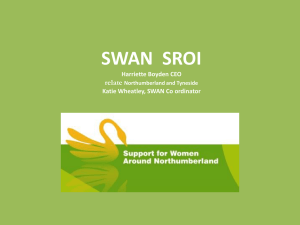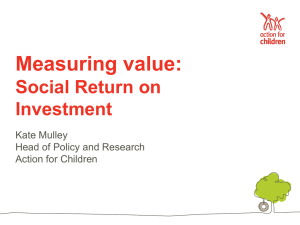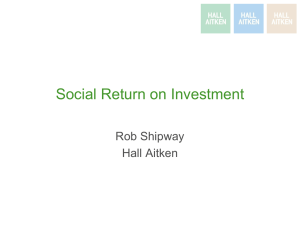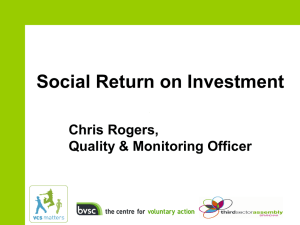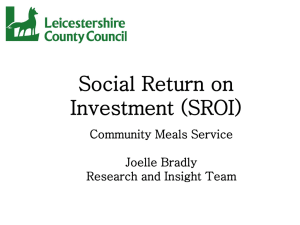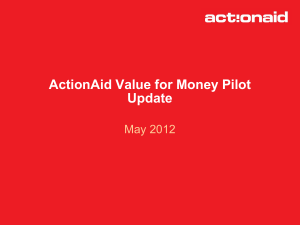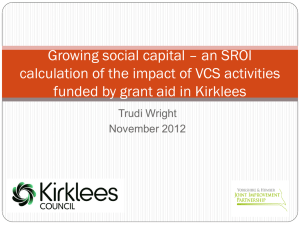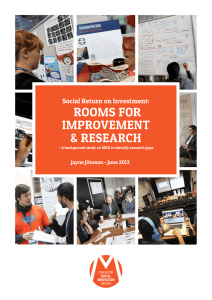October20Presentation
advertisement
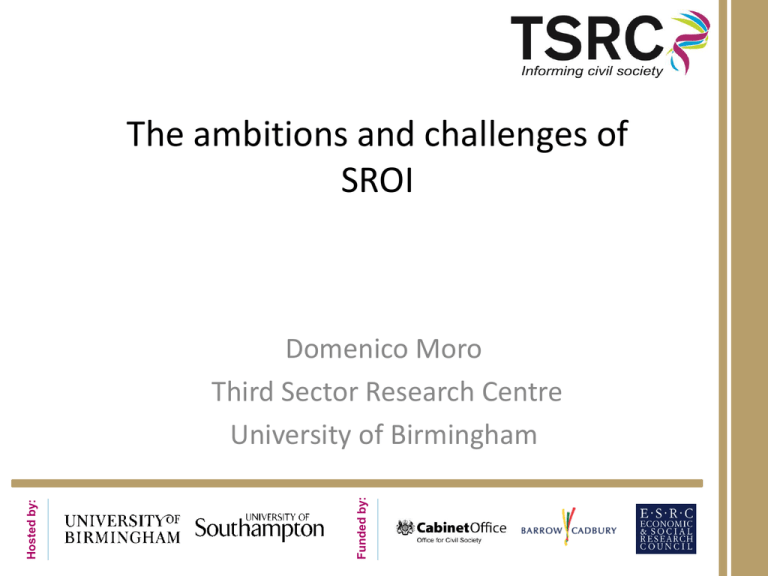
The ambitions and challenges of SROI Funded by: Hosted by: Domenico Moro Third Sector Research Centre University of Birmingham Outline: 1. The need in UK of a single recognise tool to identify and value social and environmental values; 2. SROI, framework, methodology and purpose; 3. Implication and challenge of SROI 4. Conclusion 1) The need of a single tool Trend for increased involvement of third sector in delivery of public services Social enterprises claimed to address social problems that have proved beyond states and markets Foundations are keen to understand where their donations can achieve the highest social return However: – Little evidence to support claims that the third sector is better able to deliver social outcomes – There are no commonly accepted ways of measuring social outcomes – This makes it difficult for states and philanthropists to decide who to allocate resources to 2) SROI, framework, methodology and purpose; • What is SROI? OTS (2007) Logic Ebrahim and Rangan (2010) 2) SROI, framework, methodology and purpose; • SROI is an adjusted cost benefit analysis • It aims to highlight and strengthen social and environmental values contributed by third sector organisations • … with the added value of enlightening and educating organisations and stakeholders • Stakeholder involvement is one distinctive feature Cost Benefit Analysis (CBA) • Form of economic analysis to compare costs and benefits, over time; • Need to express cost and benefits in current monetary terms; – Tangible and intangible costs and benefit • Methodologies often used to measure intangible costs and benefits: – Willingness to pay (or to accept = ‘compensation’) – Contingent evaluation – Revealed preferences 2) SROI, framework, methodology and purpose; Ambitions Measuring soft and hard outcomes To develop consistency (while keeping flexibility) For use by organisations, commissioners and funders Challenges methodological and contextual … general and inherent to social impact measurement … specific for SROI 2) SROI, framework, methodology and purpose; As with CBA, SROI combines in the form of a cash flow, the ratio of (discounted) costs and benefits over a certain period of time; • Both deal with tangible and intangible costs and benefit • Stakeholder consultation is distinctive to SROI • SROI aims to combine methodological rigour with an inclusive, democratic process SROI vs CBA • As with CBA, SROI combines in the form of a cash flow, the ratio of (discounted) costs and benefits over a certain period of time; • In many SROI evaluations – Many costs are tangible; – Many “social” benefits are intangible (and are often given high valuations, and hence a high overall return); Tangible vs Intangible (from SROI guide 2009) • Year 1 of Wheels to meals activity Tangible Intangible TOTAL Cost £24,375 £18,000 £42,375 Benefits £0 £82,508 £82,508 SROI and valuing intangible social benefits • Public spending figure as proxy for social change such as; – NHS average spending (costs) – Criminal justice costs – Unemployment benefits • Do not represent any actual financial savings (which would be closer to marginal rather than average costs) 2) SROI, framework, methodology and purpose; Valuing volunteering • How is this valued? Minimum wage, average wage, wage value equivalent to activity? • An input or output or outcome? • What are the opportunity costs? – Organisations: recruitment and management of volunteers – For volunteers: time allocation between work, leisure and volunteering 3) Implication and challenge of SROI Deadweight, displacement, attribution, drop off Framing impact in time and space: - What happened without the program? Deadweight - Can others have been affected negatively? Displacement - What can be attributed to the program? Attribution -How long the outcome last Drop off 3) Implication and challenge of SROI • Temptation to use SROI for comparing organisations despite warnings – By organisations themselves – marketing strategy – By funders and commissioners • Risk of how others interpret the findings – Over-emphasis on the ratio – Organisations feel exposed and vulnerable 3) Implication and challenge of SROI • SROI process unaffordable for many • Large number of SROIs completed have been ‘pilot projects’ • Costs range from £4,000 for a limited version, to hundreds of thousands of pounds • Costs high due to professionalisation of process required to ensure quality 4)Conclusions • The desire to promote SROI is understandable – if a single tool could identify and value social outcomes this would aid policy makers and those investing for social purpose; • There is though no consensus as to what is meant by ‘social outcomes’, even less how to measure them; • SROI is methodologically flawed; • SROI is not able to meet the demands placed upon it. It may be useful as in-house performance evaluation tool, but cannot be used to compare organisations.
